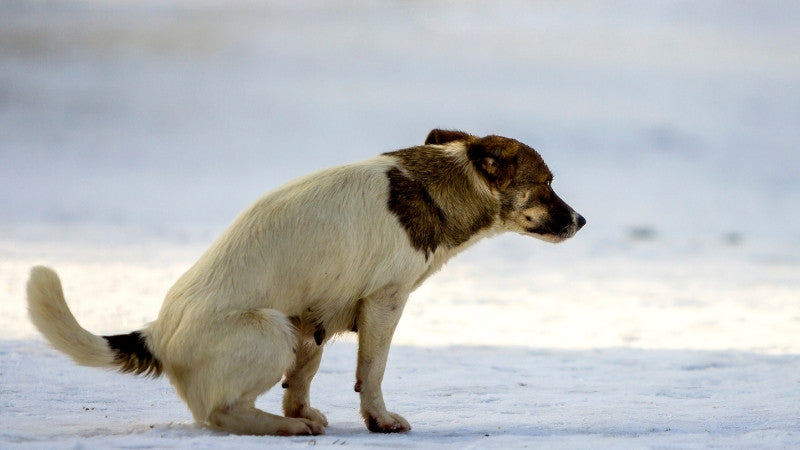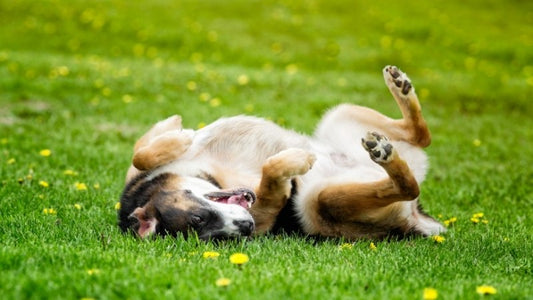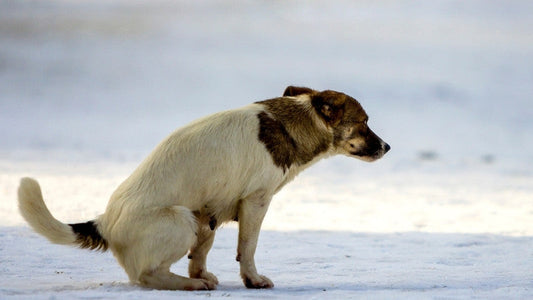You zip up your jacket, grab the leash, and open the door to a fresh blanket of snow, only for your dog to freeze in place. No sniffing, no circling, just a stubborn refusal to move. For many dog owners, this cold-weather standoff feels all too familiar.
When freezing temperatures hit, even confident pups can hesitate. Their paws sting, scents vanish under layers of snow, and that warm house suddenly feels far more inviting than an icy yard. Small breeds or dogs with short legs often struggle the most, while others simply dislike the strange texture beneath their feet.
The good news is that with a little patience, warm winter gear, and a few simple tricks, your pooch can learn to poop in snow comfortably. Stay with us to uncover why this happens and how to help your pup handle those frosty bathroom breaks.
Reasons Why Your Dog Won’t Poop in the Snow

Cold and Paw Sensitivity
Many dogs hesitate to poop in the snow because of how cold and uncomfortable it feels on their paw pads. The shock of icy ground can make them lift their feet or refuse to stay still long enough to relieve themselves. For small breeds or short-haired pups, this discomfort is even stronger since they lose body heat faster than thicker-coated dogs.
The sensation of snow itself can also be unsettling. It’s slippery, uneven, and sometimes too deep for short-legged dogs to feel secure. According to PetMD, discomfort can begin when temperatures drop below 45°F, while short-haired dogs struggle once it dips under 32°F. At 20°F or below, every breed faces a real risk of frostbite or hypothermia during extended exposure.
These freezing sensations make bathroom breaks stressful, especially when snow covers familiar scents that usually guide a dog’s routine.
Scent and Surface Confusion
Dogs experience the world through scent, and snow completely changes that world. What was once a familiar yard suddenly smells blank, erasing the invisible map your dog uses to locate their usual potty area. Puppies trained on grass, leaves, or pee pads often find the sudden shift in surface confusing, unsure whether this cold white layer is a place where they’re allowed to go.
In normal conditions, dogs circle and sniff before going to the bathroom because scent cues confirm it’s the right spot. When snow covers the ground, those clues vanish, forcing them to start from scratch each time they step outside. Research from Healthy Paws shows that dogs’ scent-tracking ability drops noticeably in frozen environments, which adds to their hesitation.
This sensory confusion explains why even confident pups can seem lost or distracted during winter potty breaks. To them, the yard no longer feels familiar as it smells like a whole new world.
Breed and Coat Type
Not all dogs handle winter weather the same way. Some seem born for it, bounding happily through snow without hesitation, while others take one step outside and immediately want to head back in. The difference often comes down to breed and coat type.
Cold-weather breeds like Huskies, Malamutes, and Samoyeds are built for snowy conditions. Their thick double coats act as insulation, and their strong metabolisms help them stay warm even when the temperature drops. For these dogs, pooping in the snow feels as natural as a summer walk.
On the other hand, small or short-haired dogs such as Chihuahuas, Dachshunds, and Terriers can feel the chill almost instantly. Their thin coats offer little protection, and their smaller body mass makes it harder to retain heat.
Senior dogs or those with arthritis may also find cold conditions uncomfortable, as stiffness in their joints can make bathroom breaks in freezing air more challenging.
Behavioral “Shutdown” or Stress Response
When a dog steps onto the snow and suddenly refuses to move, it’s not always about the cold itself. Some pups experience what’s known as a behavioral “shutdown.” This happens when new textures, freezing air, and unfamiliar surroundings overwhelm their senses. Instead of adjusting, they pause completely.
Dogs thrive on routine, and even small changes can throw them off. The sound of crunching snow, the lack of scent cues, and the shock of cold paws can all make them freeze in uncertainty. Common signs include standing still, tucking the tail, or trying to head straight back inside.
What looks like stubbornness is usually stress. Your dog isn’t being difficult; they’re just unsure how to react to an unfamiliar environment and are waiting for reassurance before continuing.
How to Encourage Your Dog to Poop in the Snow?

1. Create a Potty Path and Familiar Zone
The crunch of snow under your boots might feel peaceful, but for many dogs, it’s unsettling. When your dog won’t poop in snow, creating a familiar potty zone can make a big difference. Start by shoveling a clear path from the door to a small open circle, ideally uncovering grass or dirt. This gives your pup a recognizable surface and makes winter bathroom breaks less stressful.
Dogs depend on texture and scent to locate their usual potty area. When snow hides these cues, they lose their bearings. Clearing the ground helps restore familiar smells and a sense of normalcy. Always guide your dog to this same spot to build a consistent routine they can rely on, even in freezing temperatures.
You can make the area more inviting by:
-
Adding scent markers: Place a small amount of old waste in one of Pogi’s compostable poop bags or use a paper towel with your dog’s urine to remind them it’s the right spot.
-
Keeping it accessible: Flatten snow for smaller breeds like Dachshunds or Yorkies so their short legs don’t get buried.
-
Providing comfort: Choose a spot shielded from wind or close to a fence to reduce the chill.
This familiar zone becomes a safe, reliable place for your pup to go to the bathroom when winter weather makes everything else feel strange.
2. Use Protective Gear for Warmth and Comfort
Getting your dog to poop in snow often starts with making them comfortable enough to step outside. Just like people bundle up in winter, dogs need the right gear to handle freezing temperatures and icy ground. Coats and boots are not fashion pieces; they help maintain body warmth and protect sensitive paw pads from ice, salt, and snow.
Investing in the right winter gear can make outdoor potty breaks much smoother.
-
Choose insulated, waterproof boots that cover the paw pads and ankles. The right fit matters; if they’re too tight, they can cause irritation, while loose boots tend to slip off mid-walk.
-
Apply paw balm before and after walks. A thin layer made with beeswax or shea butter creates a protective barrier that shields against salt and ice melt. Reapply after cleaning your dog’s paws once you’re back inside.
-
Help your dog adjust gradually. Many pups resist boots at first, lifting their legs dramatically or refusing to move. Start indoors, letting them wear one or two boots for short sessions while offering treats and praise to build a positive association.
Some small breeds may refuse to move when first wearing boots. Introduce one boot at a time to help them adapt. If your pup still dislikes them, keep paw fur short to prevent ice buildup and rinse their feet with warm water after every walk.
3. Maintain Routine and Optimize Timing
When winter weather turns harsh, sticking to a consistent schedule can help your dog adjust faster. Dogs thrive on routine, and sudden timing changes can make them anxious or hesitant to go outside.
Keep their usual morning and evening potty breaks intact so they continue associating those times with bathroom trips, even when the ground is covered in snow.
Try to plan walks during the warmest part of the day. Late morning or early afternoon often brings temperatures that are about five to ten degrees higher, making it easier for cold-sensitive breeds to handle outdoor elimination.
-
Opt for shorter but more frequent outings. Instead of two long walks, offer four or five quick trips outside. These brief sessions reduce discomfort while reinforcing that outdoor breaks still mean “business time.”
-
Stay close to your dog. Standing beside them shows reassurance and encourages them to focus on the task rather than the cold.
-
Keep energy calm and consistent. Excited tones or sudden movements can distract your dog from pooping. A quiet, steady presence helps them relax.
-
Use verbal cues. A simple phrase like “Go potty” repeated at each outing helps create a strong link between the command and the action, which becomes useful when the environment changes.
Maintaining familiar timing and tone gives your dog confidence to continue their normal routine, no matter how cold or snowy it gets outside.
4. Use Positive Reinforcement and Patience
When your dog finally decides to poop in the snow, timing your reaction is everything.
Immediate praise and rewards help them connect the action with approval. Offer a small, high-value treat within a few seconds after they finish and pair it with verbal praise such as “Good potty!” in a cheerful tone. This instant feedback teaches them that going outside, even in the cold, earns something positive.
Keep rewards linked to the location. Hand out treats while still outdoors so your dog associates success with the act itself, not the return to warmth inside the house.
-
Skip punishment. If accidents happen indoors, remember that it’s usually due to discomfort, not disobedience. Scolding only increases anxiety and delays progress.
-
Stay close during bathroom breaks. Many dogs feel uneasy in freezing weather and prefer having their owner nearby for reassurance.
-
Add gentle movement. Some pups focus better when they’re relaxed, so tossing a soft snowball or walking in circles can help them loosen up before stopping to poop.
Warmth, calm encouragement, and consistency teach dogs that snow is just another surface to conquer. With patience, even the most hesitant pup can learn that winter potty breaks are no big deal.
5. Provide Indoor or Alternative Options for Severe Conditions
Even the hardiest breeds can find outdoor bathroom breaks unbearable when the temperature drops below fifteen degrees Fahrenheit. In such extreme cold, having a temporary indoor setup keeps your dog safe and prevents discomfort.
-
Use indoor potty pads or grass mats. Reusable grass mats or layered pee pads work well for quick bathroom breaks. Small dogs often adapt easily to litter box setups lined with pads or fake turf.
-
Create sheltered zones. Garages, enclosed porches, or covered balconies can serve as makeshift potty areas protected from wind and freezing air.
To prevent confusion later, plan a transition back outdoors once conditions improve. Gradually move the indoor pad closer to the door each day until it’s back outside. This helps your dog maintain their routine without backtracking on training.
Scent can make the shift easier. Rub a small piece of used waste or a pad with your dog’s previous scent onto the new spot to create familiarity.
Think of indoor arrangements as a winter safety net rather than a permanent solution. If your dog refuses both indoor and outdoor options for more than a day, it’s best to contact a veterinarian, as constipation or stress-related digestive issues can develop quickly in cold weather.
Why Pogi’s Compostable Poop Bags Are Perfect for Winter Walks?

When the air is cold and the ground is slick, even simple tasks like picking up dog poop can feel complicated. Plastic bags often become stiff, tear easily, or are too hard to open while wearing gloves. In winter, you need something sturdy, flexible, and easy to handle.
Pogi’s Plant-Based Compostable Poop Bags are built for these conditions. They stay soft and pliable even in freezing temperatures, making cleanup quick and simple. The material is thick enough to block odor and prevent leaks, giving you a cleaner, more comfortable experience.
Each bag is fully compostable and made from plant-based materials, so every pickup helps reduce waste and protect the environment. With Pogi’s bags, winter walks become easier, cleaner, and more eco-friendly for both you and your pup.
Stay Warm, Stay Consistent, and Stay Eco-Friendly
Winter walks test patience for both pups and their people. Cold paws, fading scents, and frozen ground can turn a quick bathroom break into a standoff. The good news is that comfort, routine, and a little reassurance go a long way. Once your dog learns that snow is just another surface, those frosty mornings become much easier to handle.
Make each trip outside feel less like a challenge and more like teamwork. Wrap your pup warmly, keep your tone calm, and let encouragement do the rest. And when it’s time to clean up, choose a solution that’s kind to the planet as well as your hands.
Winter walks do not have to be stressful or messy. Keep your dog comfortable and your cleanup effortless with Pogi’s Compostable Poop Bags, the eco-friendly choice that stays strong even in the cold.





